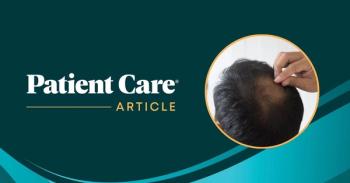
Primary Care Procedures: Trephination of Subungual Hematoma
Blood under the nail can be easily removed-and the pain almost completely relieved-by timely nail trephination. Here: techniques that have worked well in my practice.
Subungual hematoma is a fairly common condition. The severe pain that results, caused by the buildup of pressure in a closed space, persists for days if the condition is not treated. However, the blood under the nail can be easily removed-and the pain almost completely relieved-by timely nail trephination. Here I describe techniques that have worked well in my practice.
WORKUP
Figure 1 – The subungual hematoma on this patient’s left thumb would be classed as complex, on account of the damage to the cuticle. (Courtesy of Alexander K. C. Leung, MD)
Subungual hematomas may be simple or complex. Complex hematomas are accompanied by a fracture, nail base dislocation, tissue loss, or skin laceration (
Although most subungual hematomas that appear simple are not accompanied by fracture, it is usually wise to obtain radiographs to be sure. However, some authorities suggest that radiographs are unnecessary in patients who exhibit no worrisome findings after the hematoma is drained.2
When a sudden darkening appears beneath a nail following an injury, the diagnosis of subungual hematoma is fairly straightforward. If the patient has no history of significant trauma, consider other conditions that may have a similar appearance, such as subungual melanoma, subungual nevus, and Kaposi sarcoma.1 PREPARATION FOR DRAINAGE
Nail trephination can be successfully performed up to 36 hours after injury-and possibly even later-because the blood under the nail will not coagulate during this period.3 An underlying fracture is not considered a contraindication to nail trephination.3
Before drainage, prepare the nail with povidone-iodine solution or alcohol. If the only procedure to be performed is trephination, local anesthesia is generally not necessary.
Some authorities have recommended removing the nail plate and repairing the nail bed for subungual hematomas that involve more than 50% of the nail. Because nail bed repair is difficult at best, and because the nail itself acts as an anatomical splint, this recommendation seems to add risk and pain with little benefit. Better data support the less invasive approach.1 If the nail base is dislocated, however, as is often the case when a crush injury involves a tuft fracture, I do remove the nail and repair the bed.
DIFFERENT TREPHINATION TECHNIQUES
Figure 2 – An electrocautery unit such as this may be used to drain a subungual hematoma by melting a hole in the nail.
There are a variety of drainage methods. One of the techniques most commonly taught to new practitioners is to employ heat to melt a hole in the nail. A heated paper-clip tip or a portable medical electrocautery unit may be used (
At least 2 medical devices for draining subungual hematomas quickly and painlessly-and without heat-have been described. The first is a medical drill (PathFormer).4 Although I have no experience with this device, it is reported to be quite effective and painless. The second device, a carbon-dioxide laser, has also been used to drain subungual hematomas without pain.2 This might be a good choice for a dermatologist or primary care provider who already has one in the office. Despite their advantages, the cost of both these devices would likely be an obstacle.
HOW TO DRAIN A SUBUNGUAL HEMATOMA WITH AN 18-GAUGE NEEDLE
My preferred method for draining a subungual hematoma is to use an 18-gauge needle as a twist drill; this method employs easily accessed equipment and is practically painless. After applying a topical antiseptic, such as povidone-iodine solution, position a hypodermic needle with the tip in the center of the hematoma and hold the hub between the index finger and thumb (
Figure 3 – To drain a subungual hematoma with an 18-gauge needle, hold the hub between your thumb and index fingers and position the tip in the center of the hematoma. Then roll the needle back and forth so that it slowly bores into the nail plate.
Figure 4 – When draining a subungual hematoma with a needle, try to stop just before the needle reaches the sensitive nail bed.
AFTER-CARE AND FOLLOW-UP
Figure 5 –The longitudinal ridging evident on this patient's fingernail is the result of a prior subungual hematoma with fracture.
After the hematoma has been drained, use a 4 3 4-in gauze pad to wick up as much blood as possible. One source has suggested using a capillary tube for this purpose.2
Finally, apply a sterile dressing. Consider sending the patient home with a sterile needle to use should dried blood block the hole. Antibiotics may be prescribed but are generally unnecessary even if there is an accompanying fracture.
Be sure to warn the patient that the nail may be lost, although eventually a new one will grow to replace it. Even more important is to warn the patient that there is a 2% to 15% risk of permanent nail deformity as a result of the initial injury to the nail bed (
Simple subungual hematomas rarely require further care. Complex hematomas that are sutured or involve fractures of the distal tuft will require monitoring of wound healing, suture removal, and/or referral to an orthopedist.
References:
REFERENCES:1. Fastle RK, Bothner J. Subungual Hematoma. Available at:
3. Blumstein H. Incision and drainage. In: Roberts JR, Hedges JR, eds. Clinical Procedures in Emergency Medicine. 3rd ed. Philadelphia: WB Saunders; 1997:656-658.
4. Salter SA, Ciocon DH, Gowrishankar TR, Kimball AB. Controlled nail trephination for subungual hematoma. Am J Emerg Med. 2006;24:875-877.
Newsletter
Enhance your clinical practice with the Patient Care newsletter, offering the latest evidence-based guidelines, diagnostic insights, and treatment strategies for primary care physicians.
















































































































































































































































































